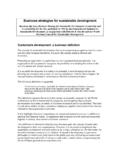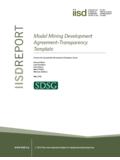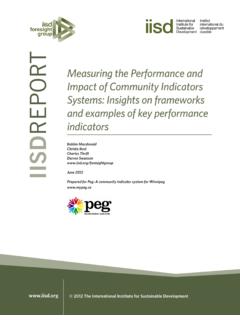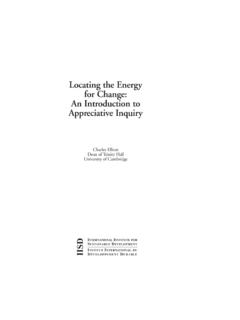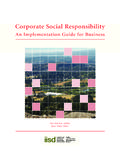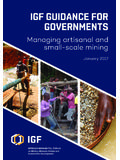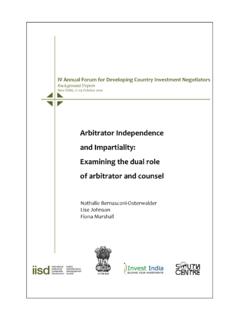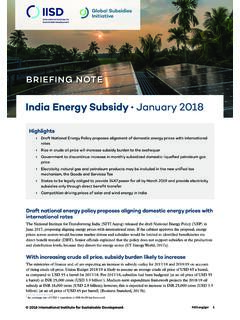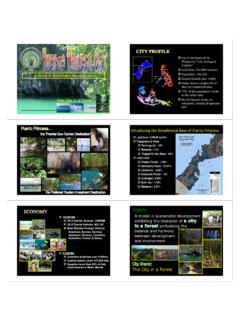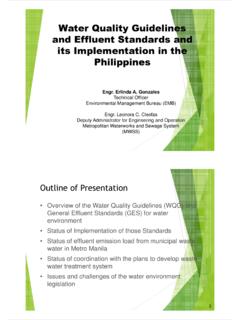Transcription of Philippines Case Study - IISD
1 Philippines case Study Unedited Working Paper Philippines case Study Analysis of National Strategies for Sustainable Development This document is one of 19 country case studies that form the knowledge base for a synthesis report entitled National Strategies for Sustainable Development: Challenges, Approaches, and Innovations Based on a 19-country Analysis. The synthesis report and country case studies are available electronically at: measure/ June 2004. Notice to Reader Information in the country case studies was obtained primarily from publicly available sources ( , Internet and literature sources) and, where possible, was supplemented through interviews with government officials. The information was up-to-date as of May 2004. Every effort was made to ensure that official national sustainable development focal point contacts had the opportunity to provide feedback on the research, but such contacts were not successful in all cases.
2 This case Study is in an unedited, working paper format. These case studies are made publicly available to add to the national sustainable development strategy knowledge base. The project's research partners accept responsibility for any inaccuracies or omissions. The views expressed in this working paper do not necessarily represent the views of the funding partners. The research partners welcome your comments on this country case Study . Please e-mail comments to Darren Swanson at This National Sustainable Development Strategy research project is a collaborative effort. Its research partners are the International Institute for Sustainable Development (IISD), the Canadian consulting firm Stratos Inc., and the Environmental Policy Research Centre of the Freie Universit t Berlin (FFU). The Study has been funded by Deutsche Gesellschaft f r Technische Zusammenarbeit (GTZ; commissioned by the German Federal Ministry for Economic Cooperation and Development BMZ), the Canadian International Development Agency (CIDA), Department of Foreign Affairs Canada, and Environment Canada.
3 Advisors to the project include IUCN The World Conservation Union and the UN Commission on Sustainable Development. Prepared by: Mireia Tarradell Environmental Policy Research Centre Freie Universit t Berlin Ihnestr. 22, 14195 Berlin, Germany 1. Philippines case Study Unedited Working Paper 1 Introduction: Philippines Description The Republic of the Philippines is one of the largest island groups in the world, numbering more than 7,100 islands located in Southeast Asia, between the philippine Sea and the South China Sea, east of Vietnam. The archipelago consists of seventy- three provinces and Manila is the capital city. After approximately 350 years of colonial rule (by Spain and USA later), the Philippines inagurated in 1946 its independent republic. Democratic alternation between the political elite was interrupted in 1972 to experience constitutional authoritarism for more than a decade. With the new regime in 1987 civil liberties have been restored.
4 Economy The figures for overall GDP and GDP per capita are, respectively, US$ bio. and US$4,600 (2002 est). The country faces a pervasive poverty problem, with almost 40% of the population below the poverty line1. The UNDP Human Poverty Index is , placing the country as the 28th poorest among 94 developing countries. The GINI index is , placing the Philippines among the top 34 countries in the world for unequal income distribution. Manufacturing, the most important production sector, accounts for around 25% of GDP (textiles, pharmaceuticals, chemicals, wood products, food processing and petroleum refining). The economy is mainly oriented towards the domestic market, despite the development since the 1970s of labour- intensive export manufacturing (electronics and automotive parts). The CO2 emissions for the Philippines in 1998 were metric tons per capita. Agriculture, fishing and tourism are other important sectors.
5 The informal sector is estimated to employ in the Philippines for up to twice as many people as the formal sector. And overseas employment represents a major source of income for philippine households. One of the fundamental reasons for the failure of the philippine economy to take off along with similar economies in East Asia lies in the distribution of land (CIA World Fact Book 2003, WB 2003, UNDP 2003, EIU 2002). Society Since January 2001 President Macapagal-Arroyo occupies the presidency after civilian coup, backed by the military, until elections take place in May 2004. The Philippines is a pluralist democracy, with an executive presidency, a bicameral Congress and a Supreme Court that can rule on the constitutionality of government actions. The constitution introduced in 1987 provides of a single six-year presidential term. The president is chief executive, head of state and commander-in-chief. The legislature is bicameral, with a Senate of 24 members elected at large' (on the nationwide ballot) and a House of Representatives composed of 208 members directly elected by district and up to 52 members chosen by party list (CIA World Fact Book 2003).
6 One of the problems faced by the Philippines is the level of official corruption 1. Poverty Line or Poverty Threshold refers to the cost of the basic food and non-food requirements (valued in philippine peso). In the philippine official methodology, the poverty line may be viewed as the minimum income required to meet the food requirements and other non-food basic needs (National Statistical Coordination Board 1997). The annual per capita poverty threshold was estimated at PhP11,906 (US$ ) in 2002. With this threshold, a family of five members should have a monthly income of PhP4,961 (US$88) to meet its food and non- food basic needs (NCSB 2004). 2. Philippines case Study Unedited Working Paper that have resulted in, inter alia, the exploitation of the nation's natural resources for the profits of foreign capital and domestic elites (PHILNET-WSSD 2001). The archipelago has a population of 84 million and its growth rate is (both 2003.)
7 Est) creating a drag on development and exerting severe pressure on the environment. With an average population density of 282 inhabitants per sq km, higher population density is located in metropolitan Manila, whereas other southern islands are sparsely populated, and where there are located some armed conflicts and terrorist groups. The Human Development Index (HDI) value for 2001 was , ranked 85th of 175. countries (EIU 2002, UNDP 2003, WB 2003). Environment The land mass consists of 300,179 sq km, of which 49 % is classified as forest (although only 21% is under forest cover) and 34% is under agricultural cultivation. The role of natural disasters has increased over time, signaling the rise in environmental degradation. Major problems are floods in lowlands, loss of biodiversity, air and water pollution, but also damage of marine and coastal resources, coral reefs and mangrove areas. With the largest area of developed estuarine fishponds in South-east Asia, sustenance fishing has been in overall decline reflecting the overfishing of inshore waters.
8 El Ni o and La Ni a episodes have caused respectively, protracted droughts and hurricane devastation in many parts of the country. The Philippines ranks number 117th with an Environmental Sustainability Index (ESI) of (EIU 2002, NCSD 2001a). Note to readers This Study draws mainly from governmental reports. Sporadically, secondary sources have also been used such as evaluation reports for the UNDP's Capacity 21. Programme, a third party report on the philippine Council for SD of the World Resources Institute or the evaluation report by the philippine NGO Network for the WSSD. Table 1: Profile by Selected Indicators Indicator Value Human Development Index (and ranking)- 2001 (85th). Human Poverty Index (and ranking)- 2001 (28th). Environmental Sustainability Index (and ranking)- 2002 (117th). GHG Emissions- 1998 Metric tons per capita of CO GDP and GDP per capita- 2002 est. US$ bio. and US$4,600. Source: CIA World Fact Book 2003, UNDP 2003, WB 2003.
9 2 Content of the National Sustainable Development Strategy Initiatives on sustainable development in the Philippines can be traced back as early as the 1980s. The first concentrated move towards SD in the Philippines began in 1987 with the drafting of the philippine Strategy for SD (PSSD). The overall goal of 3. Philippines case Study Unedited Working Paper the strategy is to achieve economic growth with adequate protection of the country's biological resources and its diversity, vital ecosystem functions and overall environmental quality'. This strategy focus mainly on two of the three dimenions of SD, i. e., the economic and the environmental. The PSSD was presented at the United Nations Conference on Environment and Development, UNCED, in Rio de Janeiro, Brasil. Following the adoption of the PSSD the government kicked-off a broad consultation process, that ended in 1996 with the adoption of the national plan of action for SD, entitled The philippine Agenda 21: A National Agenda for Sustainable Development for the 21st Century (PA 21) by Memorandum Order n 399 ( philippine Council for Sustainable Development 1997).
10 This process benefited also from the creation of the semi-governmental body, the so-called philippine Council for Sustainable Development (PCSD), in 1992. Although the philippine government calls the PA 21 its national plan of action for SD it actually acts as the SDS as integrates to a certain extent a social dimension that was generally overlooked in the PSSD. In short, the PA 21 is a wide-ranging multi-dimensional strategy, which calls to intregrate SD concerns in all decision-making structures not only within the government but also in civil society. The so-called Enhanced philippine Agenda 21. will be completed by June 2004 and will then be presented to the philippine Council for SD for approval (Encabo 2004). Strategy Content The PA 21 advocates a fundamental shift in development approach and aims at introducing an ecosystem-based and people-centred approach. It envisions a better quality of life'. It is structured along 3 major axis: the Principles of Unity (chapter 1), the Action Agenda (chapter 2) and the Implementation Strategies (chapter 3).
